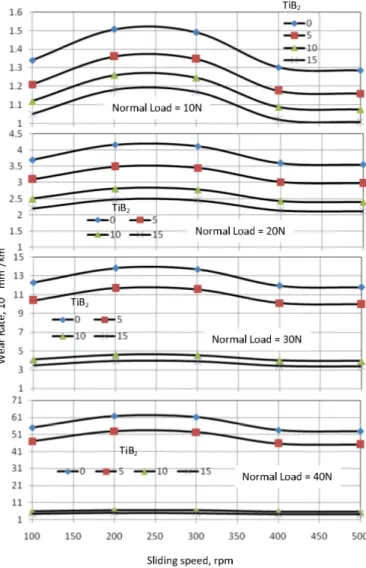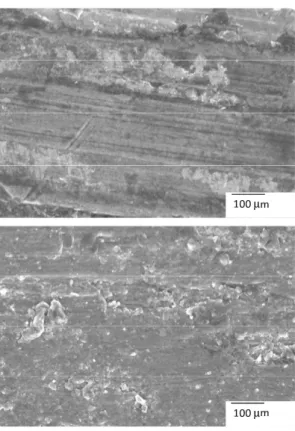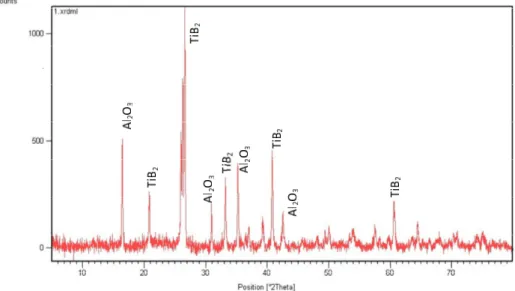A study of microstructure and wear behaviour of TiB
2/Al metal
matrix composites
Abstract
The present paper deals with the study of microstructure and wear characteristics of TiB2reinforced aluminium metal
matrix composites (MMCs). Matrix alloys with 5, 10 and 15% of TiB2 were made using stir casting technique. Effect
of sliding velocity on the wear behaviour and tribo-chemistry of the worn surfaces of both matrix and composites sliding against a EN24 steel disc has been investigated under dry conditions. A pin-on-disc wear testing machine was used to find the wear rate, in which EN24 steel disc was used as the counter face, loads of 10-60N in steps of 10N and speeds of 100, 200, 300, 400 and 500 rpm were employed. The results showed that the wear rate was increased with an increase in load and sliding speed for both the materials. However, a lower wear rate was obtained for MMCs when compared to the matrix alloys. The wear transition from slight to severe was presented at the critical applied loads. The transition loads for the MMCs were much higher than that of the matrix alloy. The transition loads were increased with increase in TiB2 and the same was decreased with the
increase of sliding speeds. The SEM and EDS analyses were undertaken to demonstrate the effect of TiB2 particles on
the wear mechanism for each conditions. Keywords
MMC composites, wear, microstructure.
A. Sreenivasana, S. Paul
Vizhianb, N.D. Shivakumarc,
M. Munirajua and
M. Raguramand,∗
a
Department of Mechanical Engineering, Sri Krishna Institute of Technology, Bangalore – India
b
Department of Mechanical Engineering, Viswesvaraiah College of Engineering Univer-sity, Bangalore – India
c
Centre for Product design and Manufactur-ing, Indian Institute of Science, Bangalore – India
d
School of Mechanical Engineering, University of Leeds, Leeds – United Kingdom
Received 24 Jun 2010; In revised form 22 Sep 2010
∗Author email: r.munusamy@leeds.ac.uk
1 INTRODUCTION
The effect of parameters such as reinforcement volume fraction and size, sliding distance and speed, applied load, sliding speed, hardness of the counter face and the properties of reinforce-ment phase on dry sliding wear behaviour were examined in [2]. The influencing parameters on sliding wear rate and wear behaviour were reported in [5–7]. Hence, the present study was attempted to improve the dry sliding wear behaviour of Al 6061 alloy reinforced with TiB2 at different loads and speeds. The worn surfaces were studied using scanning electron microscopy and the results are reported in this paper.
2 EXPERIMENTAL STUDY
The chemical composition of the matrix alloy is given in Table 1. The matrix alloy was reinforced with 5, 10 and 15% of Titanium diboride (TiB2) by using compo-casting technique. The production process of matrix alloy and composites is as follows: TiB2 particles were preheated at 400 ◦C and then it was added to the semi-solid matrix alloy at 600 ◦C. Argon
atmosphere was maintained over the melt to reduce oxidation. The mixture was rapidly heated to 750 ◦C and the composite slurry was poured into a preheated permanent iron die. Samples
for microscopic examinations were prepared based on the standard metallographic procedures, etched with Keller’s agent and examined under computer interfaced optical microscope. Optical microstructure of die-cast Al 6061-garnet particle composite is shown in Fig. 1.
A pin-on-disc machine was used to investigate the dry sliding wear behaviour of the alu-minium alloy and TiB2/Al composites as per ASTM G99-95 standards. Specimen of 10 mm in diameter and 30 mm in length were cut by specimen cutter, machined, and then polished metallographically. Wear tests were conducted with loads ranging from 10 to 60N and sliding speeds of 1.25, 2.56, 3.05 and 4.26 ms-1 for a sliding distance of 3 km at room temperature. It is noted that three samples were tested for each conditions in the present analysis. During the test, the pin was pressed against the rotating EN24 steel disc by applying the normal load. All the specimens followed a track of 100 mm diameter with tangential force. A friction-detecting arm connected to a strain gauge held and loaded the pin specimen vertically into the rotating hardened steel disc. The frictional traction experienced by the pin during sliding was measured continuously by a computer-based data logging system. After running through a fixed sliding distance, the specimens were removed, cleaned with acetone, dried and weighed to determine the weight loss due to wear. The weight of the specimen before testing and after testing was measured. Difference in weight between before and after testing was measured to determine material loss (i.e. wear) in the composite specimen. The wear of the composite specimens were studied as a function of the volume percentage of reinforcement, sliding distance, applied load and sliding velocity.
3 RESULTS AND DISCUSSIONS
3.1 Metallographic study
Microstructures of matrix alloy and 15 wt.% TiB2 reinforced Al 6061 MMCs microscopy are shown in the Fig 1. It is observed from Fig. 1(b) that in all the MMCs, TiB2 particles were rejected by theα-aluminium dendrites and were segregated in the interdendritic regions.
Figure 1 Microstructure of: (a) Al 6061 alloy (with etching) and (b) Al/15% TiB2 MMCs (without etching).
3.2 Effect of TiB2 and load on wear transition
The average wear rate of Al matrix alloy and Al/TiB2 MMCs are plotted in Fig. 2. The wear rate is compared between the normal alloy (unreinforced) and the reinforced composites in this section. It is found from figures that the wear rate of both matrix alloy and composite specimens were increased with increase in applied load. However, a lower wear rate was obtained for the MMC alloy when compared with matrix alloy. Also, the wear rate was decreased with increase in TiB2 content in the Al/TiB2 MMC specimens.
Figure 2 Wear rate of Al matrix and Al/TiB2 MMCs as the function of normal load.
wear manifested by a rapid rate of material removal in the form of generation of coarse metallic debris, and also by massive surface deformation and material transfer to the counter-face.
3.3 Effect of sliding speed on wear rate
The effect of sliding speed on wear rate is shown in Fig. 3 for Al and Al/TiB2 reinforced MMCs tested for different loads of 10, 20, 30 and 40N respectively. Wear rate was increased with increase in sliding speed during initial stage and then it was decreased with increase in sliding speed. At loads of 10N and 20N, wear rate of all four specimens were showed a nominal difference. However, a large difference in wear rate was observed at 30N and 40N loads.
3.4 Effect of TiB2 particles on wear rate
It is has been found that the transition load increases with increase in TiB2 content in the reinforced composites. Also, noticed that wear rate of the composite was lower than the base alloy. This is obviously due to the release of TiB2 by the composite specimens on to the mating surface during sliding which provide resistance to wear. Alpas and Zhang [1] studied the sliding wear behaviour of Al-Si alloys reinforced with TiB2 particles. They indicated from their study that TiB2 reinforcement provides the significant improvement in the wear resistance.
Figure 3 Wear rate of Al matrix and Al/TiB2MMCs as the function of sliding speed for different normal load.
The microstructure of the matrix base alloy and the Al/TiB2 MMC composites are shown in Fig. 4 for the load case of 30 N and speed of 300 rpm. The worn surface was characterized by fairly long and extensive ploughing grooves for the aluminium alloy. Short cracks parallel to sliding direction at the bottom of the grooves were present. It is noticed from Fig. 4 that groove width size in the aluminium alloy was bigger when compared to composites.
Figure 4 Structure of wear track of: (a) Al alloy and (b) Al /TiB2 composite materials at a load of 30N and speed of 300 rpm.
would not allow the TiB2 particle to get exposed during the sliding. The XRD spectrum of this specimen shows the presence of TiB2 and Al2O3 indicating that materials transfer occurs across the interface during the wear test as shown in Fig. 6.
Figure 6 XRD Spectrum for Al/15% Composites worm surface.
4 CONCLUSIONS
The wear rate obtained through the present experimentation is reported in this paper. It is shown in this paper that the observed wear rate was higher for the unreinforced aluminium alloy when compared to the Al/TiB2 reinforced composites. Wear rate was decreased with increasing TiB2 content in the MMC composites. The wear rate of the MMCs as well as the matrix alloy was increased with the increase in applied load. However, it was decreased with increase in speed. The MMC specimens were demonstrated abrasion wear at low loads, whereas, in the case of higher applied loads, de-lamination wear was dominant. The wear rate increased abruptly just above the critical load. The transition to high wear rate regime was induced by massive surface damage and material transfer to the counter-face. The presence of TiB2 particles would help in delaying of the transition wear from mild to severe.
References
[1] A.T. Alpas and Zhang. Wear regimes and transitions in Al2O3 particulate reinforced aluminium alloys. Mat. Sci.
Eng., 161:273–284, 1993.
[2] V. Basavarajappa, G. Chandramohan, R. Subramanian, and A. Chandrasekar. Dry sliding wear behavior of Al 2219/SiC metal matrix composites. Mat.Sci, 24:357–356, 2006.
[4] S. Kumar and V. Balasubramanian. Developing a mathematical model to evaluate wear rate of AA7075/SiCp powder metallurgy composites.Wear, 264:1026–1034, 2008.
[5] V. Ocelık, D. Matthews, and De Hosson. Sliding wear resistance of metal matrix composite layers prepared by high power laser.Surface & Coatings Tech., 197:303–315, 2005.
[6] N.S. Poonawala, A.K. Chakrabarti, and A.B. Chattopadhyay. Wear characteristics of nitrogenerated chromiurn cast irons. Wear, 162-164:580–584, 1993.
[7] M. Ramachandra and K. Radhakrishna. Sliding wear, slurry erosive wear, and corrosive wear of aluminium /SiC composite.Mat.Sci, 24:333–348, 2006.




